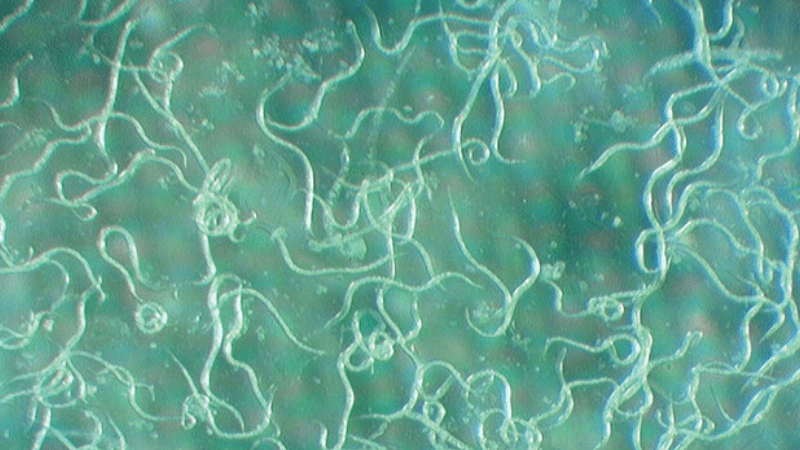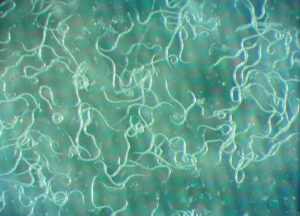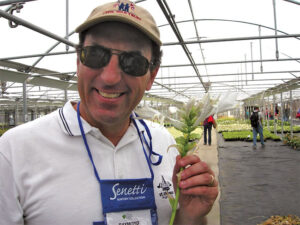
Dr. Bugs: How does growing medium affect nematodes?
Question
Can you please provide information on how the growing medium can affect Steinernema feltiae?

Answer
Steinernema feltiae is an entomopathogenic nematode used in greenhouse production systems to manage fungus gnat, Bradysia spp., larval populations in the growing medium of container-grown ornamental and vegetable plants. Steinernema feltiae is 1/64 of an inch (0.5 millimeters) long, slender, transparent and difficult to see with the naked eye (Figure 1). Infective juveniles enter the body cavity (hemocoel) of fungus gnat larvae through the mouth, anus or breathing pores (spiracles). After entering a fungus gnat larva, S. feltiae releases a bacterium, Xenorhabditis spp., which multiplies in the bloodstream (hemolymph). The bacterium produces toxins that can kill a fungus gnat larva within 24 to 48 hours.
The third stage infective juveniles inside the fungus gnat larva feed on the bacterium and liquefied insect tissues, which subsequently increases their numbers. The fungus gnat larva eventually dies of bacterial septicemia. The infective juveniles complete their development inside the dead fungus gnat larva, becoming adults that produce a new generation within the fungus gnat larva. After two to three generations (10 to 14 days) in which over 1,000 S. feltiae are produced, infective juveniles leave and search for new fungus gnat larvae in the growing medium to infect. Steinernema feltiae is susceptible to desiccation, which is why the entomopathogenic nematode is used primarily against fungus gnat larvae located in the growing medium.

Growing medium moisture and temperature can affect S. feltiae survival and ability to locate fungus gnat arvae in the growing medium; thus affecting management. In addition, persistence is influenced by growing medium moisture and temperature. Steinernema feltiae requires a moist growing medium for survival. Growing medium moisture affects the ability of S. feltiae to move through the growing medium profile (matrix), which can influence the effectiveness of S. feltiae in managing fungus gnat larval populations.
Low growing medium moisture may inhibit the ability of S. feltiae to locate fungus gnat larvae because of an insufficient film of moisture, which restricts movement within the growing medium. Furthermore, low growing medium moisture can affect S. feltiae by inducing inactivity. That is why it is important to irrigate before and immediately after applying S. feltiae. Infective juveniles will drown if the growing medium retains too much water. Therefore, avoid overwatering and use a well-drained growing medium.

Growing medium temperature can influence the effectiveness of S. feltiae in managing fungus gnat larval populations. Growing medium temperature should be between 46 and 86° F for infection, and 50 and 77° F for reproduction. A growing medium temperature greater than 90° F can negatively affect survival and reproduction; thus reducing the ability of S. feltiae to manage fungus gnat larval populations. Steinernema feltiae is most effective in managing fungus gnat larval populations when the growing medium temperature is between 59 and 79° F.
It is important to understand how growing medium moisture and temperature affect the ability of S. feltiae to manage fungus gnat larval populations, which will influence the success of S. feltiae when used in greenhouse production systems.


 Video Library
Video Library 




















